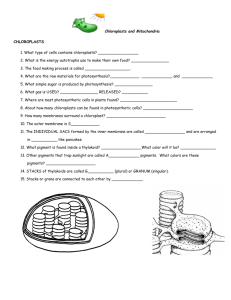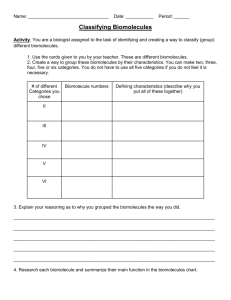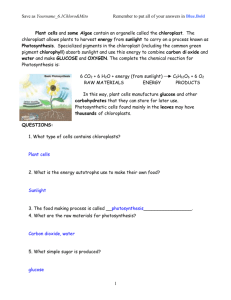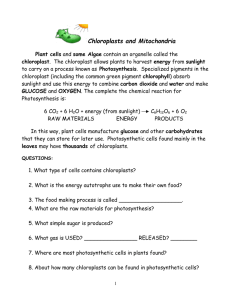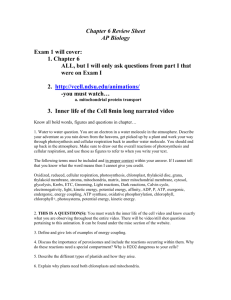Mitochondria are the powerhouses of the cell because they “burn” or
advertisement
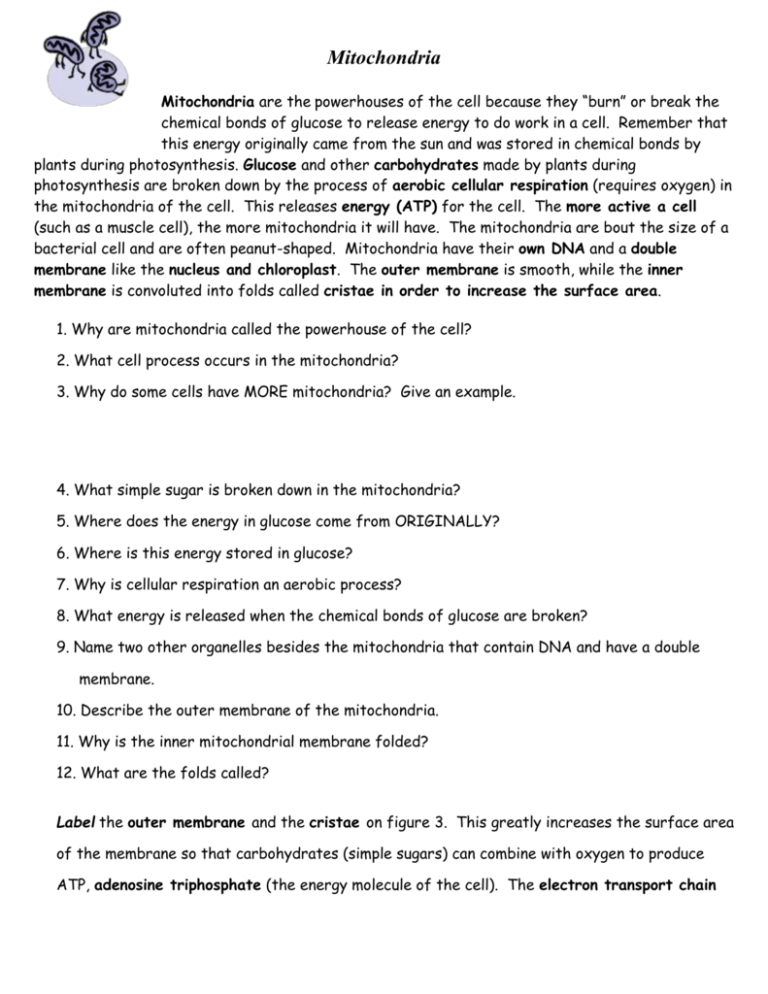
Mitochondria Mitochondria are the powerhouses of the cell because they “burn” or break the chemical bonds of glucose to release energy to do work in a cell. Remember that this energy originally came from the sun and was stored in chemical bonds by plants during photosynthesis. Glucose and other carbohydrates made by plants during photosynthesis are broken down by the process of aerobic cellular respiration (requires oxygen) in the mitochondria of the cell. This releases energy (ATP) for the cell. The more active a cell (such as a muscle cell), the more mitochondria it will have. The mitochondria are bout the size of a bacterial cell and are often peanut-shaped. Mitochondria have their own DNA and a double membrane like the nucleus and chloroplast. The outer membrane is smooth, while the inner membrane is convoluted into folds called cristae in order to increase the surface area. 1. Why are mitochondria called the powerhouse of the cell? 2. What cell process occurs in the mitochondria? 3. Why do some cells have MORE mitochondria? Give an example. 4. What simple sugar is broken down in the mitochondria? 5. Where does the energy in glucose come from ORIGINALLY? 6. Where is this energy stored in glucose? 7. Why is cellular respiration an aerobic process? 8. What energy is released when the chemical bonds of glucose are broken? 9. Name two other organelles besides the mitochondria that contain DNA and have a double membrane. 10. Describe the outer membrane of the mitochondria. 11. Why is the inner mitochondrial membrane folded? 12. What are the folds called? Label the outer membrane and the cristae on figure 3. This greatly increases the surface area of the membrane so that carbohydrates (simple sugars) can combine with oxygen to produce ATP, adenosine triphosphate (the energy molecule of the cell). The electron transport chain Mitochondria takes place across the membranes of the cristae (crista, singular). Inside the folds or cristae is a space called the matrix that contains enzymes needed for the Kreb's Cycle? Color and label the matrix yellow on figure 3. FIGURE 3 - MITOCHONDRIA Mitochondria Adenosine triphosphate (ATP) is the energy molecule used by all cells to do work. It is a nucleotide consisting of a nitrogen-containing base (adenine, thymine, cytosine, or guanine), a 5carbon sugar, and 3 phosphate groups. ATP is able to store and transport chemical energy within cells. The LAST TWO phosphate groups (PO4), are joined by HIGH-ENERGY bonds. When these bonds are broken, energy is released for cells to use and ADP forms. Enzymes help to break and reform these high-energy bonds. 13. What does ATP stand for? 14. What three main things make up an ATP molecule? 15. How many high-energy bonds does ATP contain? 16. Where are these high-energy bonds found in ATP? 17. What helps weaken these bonds so energy can be released and then later help reform them? 18. When ATP loses a phosphate group __________ is released for cells and a molecule of _________ forms. In Figure 4, LABEL the 5-carbon sugar, RIBOSE. LABEL the nitrogen-base. LABEL the 3 phosphate groups, and LABEL the 2 high-energy bonds. FIGURE 4 – ATP MOLECULE Mitochondria Questions: 19. What is the energy molecule of the cell called? 20. What macromolecule made by plants is "burned" in the mitochondria? 21. Where is chlorophyll found in the chloroplast? 22. In which part of a plant would you expect to find the most chloroplasts and why? 23. How would the number of mitochondria in an insect's wing compare to the amount found in other cells in an insect's body? Explain your answer. 24. What are the raw materials for photosynthesis? 25. What product of photosynthesis is used in cellular respiration? 26. What is the advantage of having a folded inner membrane in the mitochondria? 27. What is the energy for photosynthesis? 28. Besides chlorophyll, what other pigments are found in the chloroplasts?
